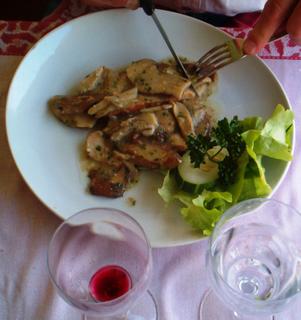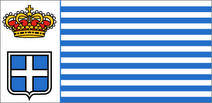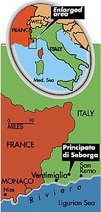 Seborga, a hilltop village closer to Nice than to Genoa on Italy’s Ligurian coast, has attracted tourists since the 1960s by billing itself as Italy’s oldest independent principality. By capitalizing on a paperwork error and declaring himself King Giorgio I, a local flower grower managed to put Seborga and its products on the map. It turns out that Seborga was never officially included on the list of principalities in the 1861 Act of Unification of Italy.
Seborga, a hilltop village closer to Nice than to Genoa on Italy’s Ligurian coast, has attracted tourists since the 1960s by billing itself as Italy’s oldest independent principality. By capitalizing on a paperwork error and declaring himself King Giorgio I, a local flower grower managed to put Seborga and its products on the map. It turns out that Seborga was never officially included on the list of principalities in the 1861 Act of Unification of Italy. Today tour buses and families head up the hill for a taste of folklore, lunch and shopping. Regardless of its attempts to market itself as an independent state, Italian law prevails in Seborga and the euro is accepted everywhere. We cautiously approach the village, driving around the ancient walls and rounding several hairpin turns along the way. We expect a border crossing and are disappointed when we don't have to show our passports.
“Come in come in, I’ll have a table ready for you at 12:30,” the man gestured towards the back of the restaurant as we stood reading the menu. Seeing that the daily special was fresh porcini mushrooms, we nodded enthusiastically and decided to tour the village before lunch. The sights are easily covered in 45 minutes, but if you stop and talk to the locals you should plan on spending 1 to 2 hours.
Make sure to stop and visit 85 year old Renata Leone in her shop, U Cuntadin, where she sells pestos, marinated peppers, olives and many other preserved vegetables from her garden. The tiny cave-like space is decorated in blue and white, Seborga’s colors, and covered with displays of old garden tools and photos of Renata with her family. My Italian is not so good, but fortunately Renata speaks French having worked in France before the war (World War II). She tells me about the busier tourist season in Summer and Spring and that her family was one of the first to sell products made in Seborga. I leave with some pesto and promise to return soon.
of old garden tools and photos of Renata with her family. My Italian is not so good, but fortunately Renata speaks French having worked in France before the war (World War II). She tells me about the busier tourist season in Summer and Spring and that her family was one of the first to sell products made in Seborga. I leave with some pesto and promise to return soon.
I stop for more food souvenirs at Ruppe Mini Market, also known as Chez Josy, down by the church and stock up on various almond cookies; these pasta alla mandorla are made in Seborga and even the label is handwritten. The official Seborga label on the bag contains information in English about the town and a sticker with the blue and white coat of arms adorns the front, a blue ribbon holds it all together. The packaging in this town is very well coordinated; all the labels in the shops are printed in white and blue and carry the official Seborga coat of arms. I am beginning to suspect that Giorgio (may I call a King by his first name?) actually worked as a marketing executive in a previous life.
“Come in come in, I’ll have a table ready for you at 12:30,” the man gestured towards the back of the restaurant as we stood reading the menu. Seeing that the daily special was fresh porcini mushrooms, we nodded enthusiastically and decided to tour the village before lunch. The sights are easily covered in 45 minutes, but if you stop and talk to the locals you should plan on spending 1 to 2 hours.
Make sure to stop and visit 85 year old Renata Leone in her shop, U Cuntadin, where she sells pestos, marinated peppers, olives and many other preserved vegetables from her garden. The tiny cave-like space is decorated in blue and white, Seborga’s colors, and covered with displays
 of old garden tools and photos of Renata with her family. My Italian is not so good, but fortunately Renata speaks French having worked in France before the war (World War II). She tells me about the busier tourist season in Summer and Spring and that her family was one of the first to sell products made in Seborga. I leave with some pesto and promise to return soon.
of old garden tools and photos of Renata with her family. My Italian is not so good, but fortunately Renata speaks French having worked in France before the war (World War II). She tells me about the busier tourist season in Summer and Spring and that her family was one of the first to sell products made in Seborga. I leave with some pesto and promise to return soon.I stop for more food souvenirs at Ruppe Mini Market, also known as Chez Josy, down by the church and stock up on various almond cookies; these pasta alla mandorla are made in Seborga and even the label is handwritten. The official Seborga label on the bag contains information in English about the town and a sticker with the blue and white coat of arms adorns the front, a blue ribbon holds it all together. The packaging in this town is very well coordinated; all the labels in the shops are printed in white and blue and carry the official Seborga coat of arms. I am beginning to suspect that Giorgio (may I call a King by his first name?) actually worked as a marketing executive in a previous life.
Before lunch I had time for one more stop: Il Cavaliere,  a shop selling everything related to medieval knights: suits of armor, knives, swords, mace, you name it. Before Seborga became a tourist destination, it was a Principality of the Holy Roman Empire and therefore heavily guarded. In 1079 it became the first cistercian state and it was where in 1118 the first 9 templars were ordained. But, that's really ancient history.
a shop selling everything related to medieval knights: suits of armor, knives, swords, mace, you name it. Before Seborga became a tourist destination, it was a Principality of the Holy Roman Empire and therefore heavily guarded. In 1079 it became the first cistercian state and it was where in 1118 the first 9 templars were ordained. But, that's really ancient history.
We were having lunch at Il Principe, one of three restaurants in Seborga. The owner, Mr. Ferrari, is known not for cars but for being Seborga’s foreign minister. Like most residents in this village, he speaks fluent French and is a gracious host. We are seated at a table on the covered back terrace where we can touch the fig trees if we reach out far enough. We dine under a portrait of King Giorgio and with a view of the Mediterranean a few miles away. Porcini mushroom tagliatelle and veal with sautéed porcinis satisfy our craving for the local delicacy. The food is simple, not extraordinary, but the setting and the characters in this village are out of this world. Other dining options in Seborga include Hosteria del Coniglio and Taverna Templare, a cheaper eatery on the main square.
 a shop selling everything related to medieval knights: suits of armor, knives, swords, mace, you name it. Before Seborga became a tourist destination, it was a Principality of the Holy Roman Empire and therefore heavily guarded. In 1079 it became the first cistercian state and it was where in 1118 the first 9 templars were ordained. But, that's really ancient history.
a shop selling everything related to medieval knights: suits of armor, knives, swords, mace, you name it. Before Seborga became a tourist destination, it was a Principality of the Holy Roman Empire and therefore heavily guarded. In 1079 it became the first cistercian state and it was where in 1118 the first 9 templars were ordained. But, that's really ancient history.We were having lunch at Il Principe, one of three restaurants in Seborga. The owner, Mr. Ferrari, is known not for cars but for being Seborga’s foreign minister. Like most residents in this village, he speaks fluent French and is a gracious host. We are seated at a table on the covered back terrace where we can touch the fig trees if we reach out far enough. We dine under a portrait of King Giorgio and with a view of the Mediterranean a few miles away. Porcini mushroom tagliatelle and veal with sautéed porcinis satisfy our craving for the local delicacy. The food is simple, not extraordinary, but the setting and the characters in this village are out of this world. Other dining options in Seborga include Hosteria del Coniglio and Taverna Templare, a cheaper eatery on the main square.
If you go:
Il Principe: Piazza Martini Patrioti, 6 Seborga 18012 (IM) Principato di Seborga Tel/Fax: +39 0184 223570.
U Cuntadin: Via Maccario, Seborga 18012 (IM) Principato di Seborga.
(Source: Food Trek http://foodtrek.blogspot.com)



